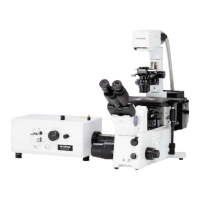APPLIED OPERATIONS/Saving, Opening and Shredding Images
IV.
OPERATION INSTRUCTIONS
IV .
2-124
Page
2-3-1-5 File Types Available for Save
The file type used for saving image in a file can be selected by the user. See section 2-
3-1-1, “Saving Images As a Series” for the operation method.
1. Click the <Experiment> button in the [Save] group box.
2. Select the file type from the [Save as Type:] drop-down list in the [Save Experiment
As] dialog box. Three file types are available as detailed below.
x Fluoview Multi Tiff(*.tif): TIFF format designed for use with FLUOVIEW.
Used for image analysis, processing, etc., on
FLUOVIEW.
x Single TIF(s) 8-bit(*.tif):
x Single TIF(s) 16-bit(*.tif) TIFF (Tagged-Image File Format) is used for image
x Single TIF(s) 24-bit(*.tif): exchange between applications or computers.
(Three types including the 8-bit, 16-bit and 24-bit
types are available.)
x Bitmap 8-bit(*.bmp):
x Bitmap 24-bit(*.bmp): The BMP format is the standard raster format of MS-
Windows.
(Two types including the 8-bit and 24-bit types are
available.)
x mVx Files (*.img, *.ani): File format for microVoxel.
Used for exchanging images with microVoxel.
In the file types above, characters inside ( ) indicate the extension when a
file is saved.
When saving a display, the file format can be selected from Single
TIF(s) 8-bit (*.tif), Single TIF(s) 16-bit (.tif), Single TIF(s) 24-bit (*.tif),
Bitmap 8-bit (*.bmp) and Bitmap 24-bit (*.bmp).
When saving an image obtained by merging more than one channel,
use a 24-bit file type.
TIP
NOTE
NOTE

